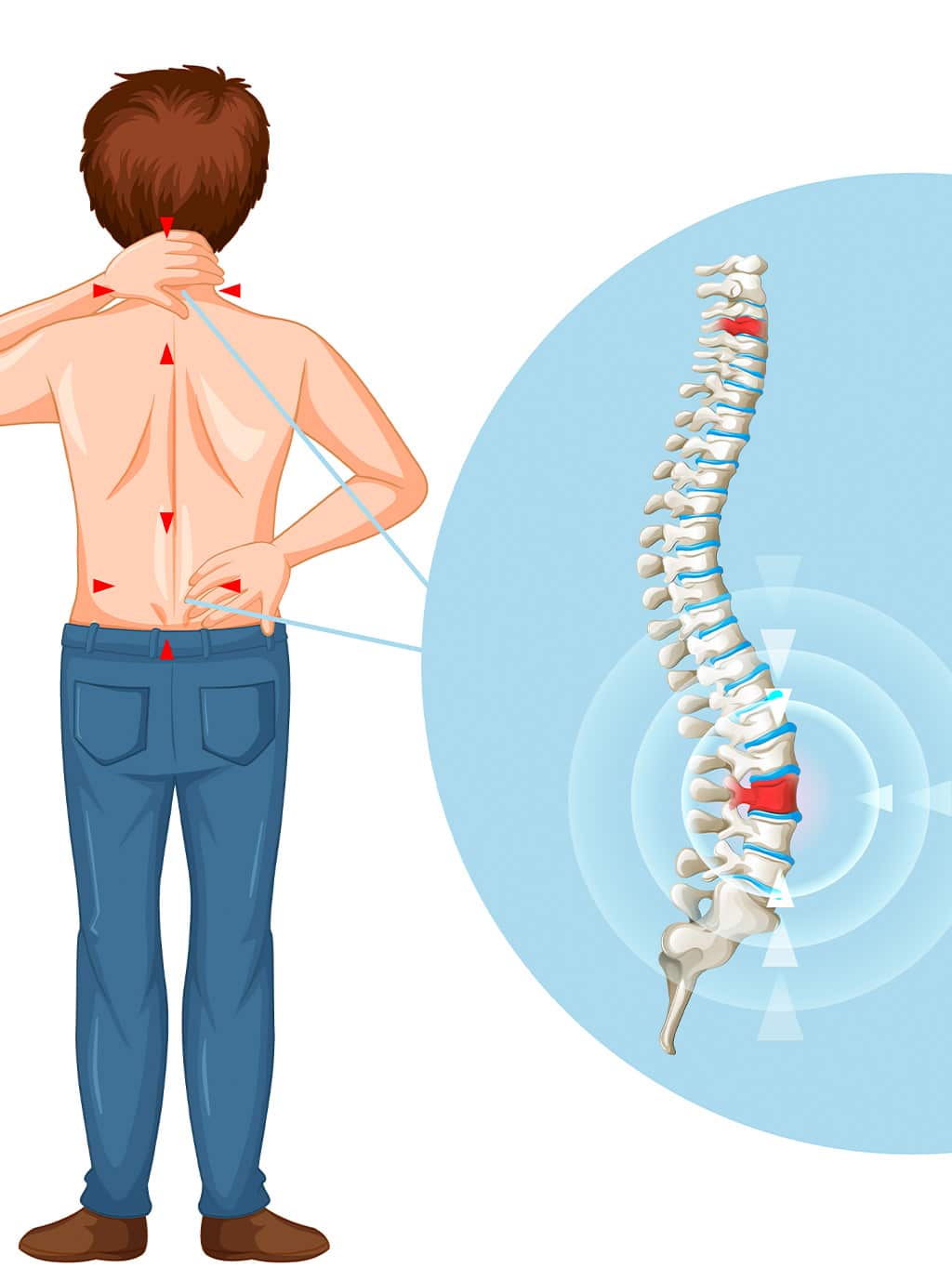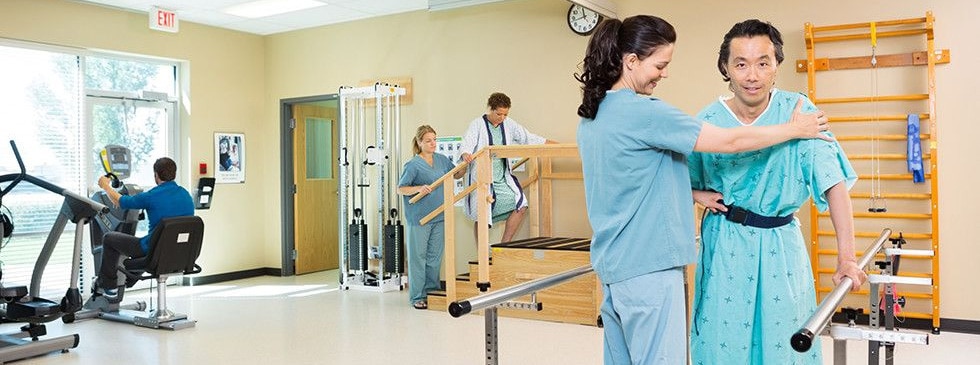
Loading. Please wait.

Loading. Please wait.
At Denville Medical, your licensed physical therapist's goal is to maximize your body's structure and increase its overall function for long-term health. To accomplish this, our physical therapists combine traditional and innovative techniques focused on increasing muscle strength and improving the body's range of motion. Our goal is to discover the root cause of your pain or mobility problems. That way, we can address the true reason why you need physical therapy, and work towards achieving long-lasting relief.
Of course, we understand that every patient is different. Your doctor can provide expert care in an encouraging environment by creating a customized treatment plan for you using modern, evidence-based research.
Some common reasons why patients need physical therapy at Denville Medical include:
1.
Sports Injuries Whether you are on the varsity team of your high school football team or a professional athlete, sports injuries are serious business. Our doctors and physical therapists will develop a plan to help you heal properly, so you can get back in the game sooner rather than later.
2.
Pre and Post Operation With decades of combined experience, our physical therapy experts know that there is a time for gentle healing and a time for aggressive physical rehab. Whether you are scheduled for surgery or have recently been released from the hospital, our therapists are here to help you recover, one step at a time.
3.
Neurological Issues At Denville Medical, we treat much more than sports-based injuries. Whether you're suffering from Multiple Sclerosis, Parkinson's, or a vestibular problem, our therapists are trained and certified to help you regain your body's optimal functionality.

Life has a habit of throwing us curveballs. Sure, some surprises only hurt your bank account, like expenses around the home. But more serious incidents, like car wrecks, can inflict physical injuries causing long-term pain. Injury-related problems like neck and back pain affect many Americans daily. Even worse, many hardworking people turn to addictive pain medication and invasive surgeries for relief, only to find themselves deeper in a hole.
If you're in chronic pain or suffer from range of motion problems, you should know that options are available for safer, more effective pain relief. One of the most commonly used solutions is physical therapy. The main goal of physical therapy is to maximize your body's mobility and increase overall function. In order to accomplish this, physical therapy techniques focus on improving range of motion and building muscle strength.
Physical therapy helps people of all ages with illnesses, medical conditions, or injuries that limit their mobility and body functionality. At Denville Medical and Sports Rehabilitation Center, our doctors and physical therapists create customized physical therapy programs to help patients reclaim their lives.
When combined with diet and exercise, many patients are able to enjoy activities that they only thought possible with youth.
Some of the most common techniques that physical therapists use to help patients include:
From improper ergonomics at your office desk to injuries sustained in car wrecks, neck pain is a widespread problem. Taking the proper preventative steps to deal with pain provides relief and can prevent the need for surgery or medication.
Generally, there are two kinds of neck pain: chronic and acute. Acute pain shouldn't last for more than six weeks, while chronic pain can last months or even years. Physical therapy is one of the most recommended treatments for neck pain. Treatments often involve reducing neck exercise, strength training, and stretching. If you're suffering from acute or chronic neck pain, it's important to have tests done by a physical therapist to determine the extent of your injury.
Neck pain is caused by a wide range of problems, like:
After identifying the underlying cause of your condition, your physical therapist will develop a comprehensive treatment to address your pain and provide long-term relief.

Back pain is one of the leading causes of disability in America. Back pain can start innocuously as a small muscle ache but can quickly become a more serious problem that disrupts daily life. Like neck pain, the best way to address the issue is to understand the root cause so that surgery is avoided.
Also like neck pain, back pain is either chronic (longer than six weeks) or acute (less than six weeks). Back pain can be caused by a number of events, like lifting a heavy item or simply sitting wrong for too long. To determine the extent of your injuries, you will need one or more diagnostic tests, like X-rays or MRI scans. Once the root cause of your condition is revealed, your physical therapist will work with Denville Medical doctors to create a treatment plan tailored to your body.
Common conditions linked to back pain include:

Experiencing a herniated disc is something most people dread, but many have to endure. Luckily, PT plays a significant role in herniated disc recovery. Physical therapy not only provides immediate pain relief, it teaches patients how to condition their bodies to avoid worse injuries.
At Denville Medical, our physical therapists and doctors have years of experience helping patients rehabilitate from herniated discs. Patients benefit from several time-tested techniques to relieve pain.
After diagnostic testing, active and passive treatments can include:

Do your hips feel uneven or misaligned? Do you suffer from hip stiffness or pain when the weather changes? Are you having trouble getting around the house like you used to? Your hips bear most of your weight, so it's no surprise that hip pain is very common among Americans.
Fortunately, physical therapy has been proven to provide relief for people dealing with acute or chronic hip pain. As with other forms of pain, you will need diagnostic testing to determine the extent of your hip problems.
Some common causes of hip pain include:
Once your hip issues are properly diagnosed, it's time to find relief. Denville Medical & Sports Rehabilitation Center offers several custom solutions, including acupuncture, chiropractic care, and personalized physical therapy.

Like hip pain, knee pain is a common condition in the U.S. and affects millions of people every year. Pain in the knee is caused by many things, including strains, injuries, age, and repetitive trauma. Sometimes, there's no apparent reason for knee pain. When it occurs, you may experience limited knee functionality, like difficulty standing, walking, sitting, and walking up and down stairs.
There are many conditions associated with knee pain, including:
If you notice symptoms like clicking or popping sounds, locking, inflammation, or sharp pains in your knee, physical therapy might be your best bet for relief.

Sometimes, surgery is the only option a patient can choose to alleviate pain from injuries and accidents. When this is the case, physical therapy plays a vital role before and after surgery.

To help you get a better sense of the scope of our physical therapy treatments, we're listing some of the most frequently asked questions that we receive at Denville Medical:
Answer : While some physical therapists rely on outdated techniques to treat patients, our team uses a combination of tried-and-true methods and modern strategies, including:
Answer : During your first visit with our physical therapist, we will complete a series of tests and screenings to establish a baseline for your care. You can expect to complete stability screenings, strength tests, and computerized range of motion tests. These tests ensure your doctor understands how your muscles are functioning. Once complete, your therapist will create a custom treatment plan for your physical therapy, so we can move forward with your care. During your time at Denville Medical, you should expect adjustments to your treatment plan as you make progress.
Answer : We get this question a lot, and we can certainly understand why. Unfortunately, we cannot provide you with an exact answer because every patient has different needs relating to their injuries and issues. Your level of stability and functionality depends on your condition, your goals, and your motivation to heal. For acute pain, patients typically experience relief in 2-3 weeks. Patients with forms of chronic pain usually feel optimal results after their first full course of therapy (4-6 weeks). Since our goal is to achieve maximum medical improvement, our doctors continuously monitor your progress and adjust treatment accordingly.
Whether you're dealing with chronic knee pain or acute back pain, relief is in sight. Rather than dangerous medicines and invasive surgeries, we specialize in non-surgical treatments like physical therapy. Our team of physical therapists, chiropractors, acupuncturists, and primary care doctors have years of experience and work hand-in-hand to give you real pain relief.
If you're sick and tired of living life full of physical pain, now is the time to act. Don't let your body deteriorate – find your new lease on life at Denville Medical and Sports Rehabilitation Center.
 973-627-7888
973-627-7888
WATERFORD TOWNSHIP, New Jersey -- The New Jersey Forest Fire Service is battling a wildfire that began burning in the Wharton State Forest on Sunday.Officials say the flames broke out in the area of Jackson Road near the Atco Dragway in Waterford Township. It has since spread to both Camden and Burlington counties.It was first reported just after 2:45 p.m.The wildfire was 100 acres in size and 0% contained as of Sunday night.Assistant State Fire Warden Bill Donnelly told Action News that residents in the area do n...
WATERFORD TOWNSHIP, New Jersey -- The New Jersey Forest Fire Service is battling a wildfire that began burning in the Wharton State Forest on Sunday.
Officials say the flames broke out in the area of Jackson Road near the Atco Dragway in Waterford Township. It has since spread to both Camden and Burlington counties.
It was first reported just after 2:45 p.m.
The wildfire was 100 acres in size and 0% contained as of Sunday night.
Assistant State Fire Warden Bill Donnelly told Action News that residents in the area do not need to be concerned by the flames.
Donnelly also said no injuries were reported and there were no evacuations.
Roughly 40 firefighters were sent into the state forest to try to control the wildfire.
Crews are now in the process of building containment lines to keep it from burning further.
Donnelly hopes to have containment lines up by Monday morning.
"Right now, things are in our favor. The wind has settled down, the sun is in. Basically, the conditions to work in are favorable for us. I don't anticipate any problems with what our plan is," said Donnelly.
He also said there is a contingency plan in place in case of an emergency.
Roads may be closed on Monday while crews work to keep the flames under control.
The cause of the fire is under investigation.
----------
* Get Eyewitness News Delivered
* Download the abc7NY app for breaking news alerts
Have a breaking news tip or an idea for a story we should cover? Send it to Eyewitness News using the form below. If attaching a video or photo, terms of use apply.
Wharton, NJ (November 1, 2023) – A traffic accident in Wharton caused two people to sustain injuries. One was seriously hurt while the other suffered minor injuries.The wreck was reported on Route 80 on Tuesday evening, October 31, at around 7:40 p.m. A Subaru SUV and a Volvo tractor-trailer were traveling on Route 80 near milepost 38.8 when the Subaru, operated by a Highland Lakes resident, age 32, quickly slowed down due to a stop in traffic caused by a prior collision.The Subaru was then struck in the rear by th...
Wharton, NJ (November 1, 2023) – A traffic accident in Wharton caused two people to sustain injuries. One was seriously hurt while the other suffered minor injuries.
The wreck was reported on Route 80 on Tuesday evening, October 31, at around 7:40 p.m. A Subaru SUV and a Volvo tractor-trailer were traveling on Route 80 near milepost 38.8 when the Subaru, operated by a Highland Lakes resident, age 32, quickly slowed down due to a stop in traffic caused by a prior collision.
The Subaru was then struck in the rear by the tractor-trailer, operated by a Scranton, Pennsylvania resident, age 63. While the man from Scranton suffered minor injuries, the other driver was seriously hurt in the crash.
Police continue to investigate the circumstances of the incident.
Our thoughts are with those with injuries. No further information has been reported at this time.
Truck accidents are often more severe than other types of crashes. The fact that trucks are so heavy and much larger than other vehicles means that, when they become involved in accidents, they usually cause severe damage to both vehicles and individuals involved. Thousands of people lose their lives per year due to truck collisions in the United States. On average, the US sees over 380,000 truck collisions per year that cause tens of thousands of people to sustain injuries and around 5,000 to lose their lives. About 6% of reported auto collisions in the United States involve large trucks.
Truck accidents can happen for numerous reasons. Some of the most common causes of truck accidents in New Jersey include:
Unfortunately, those victimized in truck wrecks often end up with financial issues that are difficult to overcome. If you or someone you love has been hurt in a truck crash, it is important to act swiftly and contact an attorney who may be able to help you recover. A Wharton truck accident lawyer can help you pursue a personal injury case to recover compensation to help cover some of the costs you face.
If you or someone you love has been injured in a New Jersey truck crash, the law office of Metro Law is here to help you recover. Our main goal is to help you receive the financial compensation and justice you need and deserve during the difficult aftermath of your recent crash. Contact our office at 800-469-6476 for your free consultation today.
By Mabel PaisAadhitya Raam Ashok, high school musician and composer, is one-of-two award recipients from Wharton Arts, the Garden State’s leading performing arts education organization. Aadhitya Raam Ashok of Edison is the winner of the inaugural Wharton Arts Annual Choral Composition Competition.“As an enthusiastic high school musician and composer, it feels wonderful to win my first choral composition competition with the Wharton Arts Annual Choral Composition Competition. I am grateful for the wo...
By Mabel Pais
Aadhitya Raam Ashok, high school musician and composer, is one-of-two award recipients from Wharton Arts, the Garden State’s leading performing arts education organization. Aadhitya Raam Ashok of Edison is the winner of the inaugural Wharton Arts Annual Choral Composition Competition.
“As an enthusiastic high school musician and composer, it feels wonderful to win my first choral composition competition with the Wharton Arts Annual Choral Composition Competition. I am grateful for the wonderful panel of judges who provided me with useful comments, along with their appreciation for my unique yet powerful music. Having my music featured by a youth choir is a great opportunity for me to gain experience into how young singers might approach my music,” said Aadhitya.
Aadhitya’s winning composition, A Bright Youthful Future, will premiere under the direction of New Jersey Youth Chorus Founder and Music Director, Trish Joyce on Sunday, May 21, at the NJYS spring concert as part of their 30th anniversary celebration.
Winner Aadhitya Raam Ashok, a senior at John P. Stevens High School in Edison, began his musical studies at the age of three in Bergen’s Yamaha Music School where he has been a recipient of the Jeffery Corolla and Frank Calabrese Scholarship for the last six years. He completed the London College of Music Diploma (DipLCM) exams with distinction and has won numerous composition awards, including being a three-time National Finalist in the Music Teachers National Association (MTNA) competition, three-time winner in the Eastern Division of the MTNA competition, and six-time winner in the NJ MTNA Composition competition. He received the Gold Medal in the National Young Maestro Composition Competition across multiple years and was finalist in the National Association for Music Education (NAfME) twice consecutively. He placed first in the Golden Key International and National Piano Composition Competition twice consecutively as well. He won the Grand Prize in the Rising Talents Festival. Learn more at aadhityaraam.com.
(Bokyung) Nina Park of Basking Ridge is the other winner of the 2023 New Jersey Youth Symphony Concerto Competition. She received her award on April 30.
(Mabel Pais writes on The Arts and Entertainment, Social Issues, Health & Wellness, Cuisine, Spirituality, and Business)
—————————————————————-
NJYC CELEBRATES 30TH ANNIVERSARY
By Mabel Pais
The New Jersey Youth Chorus (NJYC) invites all to The Journey (e.givesmart.com/events/vdN), a weekend of festivities on Saturday, May 20 and Sunday, May 21, to celebrate the Chorus’s 30th Anniversary.
Trish Joyce, Founder and Director of the Chorus, said, “We chose the theme The Journey for this celebration, not just to commemorate the journey the Chorus has been on, but in recognition of and tribute to all of the people who have joined us along the way. Inside our story as an organization are thousands of personal experiences that, taken as a whole, make us who we are today.
Our journey has been filled with dedicated choristers, parents, volunteers, and staff and guided by the vision that children and young singers deserve the opportunity to experience the beauty, passion, and joy of singing. Our north star has been the lifelong friendships made among our singers—connections that weave together a community they call home. Driving us forward on the journey is the power of music and artistry to shape and change lives, and our enduring commitment to cultivating the personal and musical potential of each child with a nurturing spirit, warmth, and acceptance. This is the legacy that we built over the past 30 years, and that we will carry with us on the journey into the future. I can’t wait to see where the path takes us next!”
PROGRAM
The anniversary weekend begins with the NJYC Family Fest on May 20 from 11:00 a.m. to 1:00 p.m. at The Grove at The Park, 200 Connell Drive in Berkeley Heights. Open to current NJYC families and their guests, as well as alumni and their families, the rain or shine event will feature games and activities, food trucks, and a DJ.
Register in advance to receive a food/beverage voucher to use at the event.
The New Jersey Youth Chorus Legacy Concert on May 20 at 8:00 p.m. at Roundtable Studios at the Park, 200 Connell Drive in Berkeley Heights, will celebrate NJYC’s vibrant past and help sustain the Chorus’s legacy. This cabaret-style fundraiser will feature NJYC alumni, current and former staff, and NJYC choristers from Coriste and Camerata. Dessert Reception to follow. Space is limited for this event and ticket sales will close on May 10.
The public is invited to the New Jersey Youth Chorus Spring Concert & 30th Anniversary Reception on May 21 at 4:00 p.m. at Our Lady of the Lake Church located at 22 Lakeside Avenue in Verona, a special anniversary edition of the Chorus’s annual spring concert with performances by all five of NJYC’s ensembles as well as an Alumni Choir comprised of alumni from throughout choirs past, including several members of the original Somerset Hills Children’s Chorus.
The program will feature treasured pieces from throughout the Chorus’s history, including Psalm 23 and Omnia Sol by Z. Randall Stroope, Brothers, Sing On! by Edvard Grieg, Flight Song by Kim André Arnesen, Yo Le Canto Todo Le Dia by David L. Brunner, and new favorites such as Rise Up by Jake Runestad, Where the Light Begins by Susan LaBarr, and Ain’t Gonna Let Nobody Turn Me Around by Dr. Rollo Dilworth.
The program will also include the premiere of the 2022-23 Wharton Arts Annual Choral Composition Competition winning piece, A Bright Youthful Future by Aadhitya Raam Ashok.
Following tradition, the program will end with the choir and alumni singing Katie Moran Bart’s Blessing, a piece that has been performed on every spring concert program since the Chorus’s inception thirty years ago.
Over NJYC’s thirty years, outstanding performances have ranged from NJPAC and the New Jersey Symphony to Carnegie Hall and the White House; from Ronan Tynan, the Chieftains, and the Celtic Tenors to the Today Show; with the South African Drakensberg Boys Choir to Queen Latifah at the Super Bowl; from regional and national music conferences to various national anthem performances at Citi Field and Madison Square Garden; from Kids for Kids outreach to educator workshops; and domestic and international tours. Through all of these life-changing and unique experiences, NJYC has kept exceptional choral music education at the forefront of its mission, creating space for personal growth and ensemble learning.
Wharton Arts
Wharton Arts’ mission is to offer accessible, high quality performing arts education that sparks personal growth and builds inclusive communities. Wharton Arts’ vision is for a transformative performing arts education in an inclusive community to be accessible for everyone. Wharton Arts is located in Berkeley Heights, New Providence, and Paterson, NJ and reaches students from 12 counties. All of Wharton Arts’ extraordinary teaching artists, faculty members, and conductors hold degrees in their teaching specialty and have been vetted and trained to enable our students to achieve their personal best.
(Mabel Pais writes on The Arts and Entertainment, Social Issues, Health & Wellness, Cuisine, Spirituality, and Business)
Ribbon-Cutting to Mark Completion of 16-Year Preservation MissionWith some fanfare and a ribbon cutting, Wharton Borough will officially complete a 16-year mission to restore one of the most remarkably preserved and unique sections of the famous Morris Canal – and of course, the festivities will be held at the 47th Annual “Canal Day Music & Craft Festival” in Wharton Borough on Aug. 20.The site at Wharton’s Hugh Force Canal Park is one of the rema...
Ribbon-Cutting to Mark Completion of 16-Year Preservation Mission
With some fanfare and a ribbon cutting, Wharton Borough will officially complete a 16-year mission to restore one of the most remarkably preserved and unique sections of the famous Morris Canal – and of course, the festivities will be held at the 47th Annual “Canal Day Music & Craft Festival” in Wharton Borough on Aug. 20.
The site at Wharton’s Hugh Force Canal Park is one of the remaining and best-preserved watered sections of the historic Morris Canal, which was responsible for the economic development of not only the Borough but the entire region 175 years ago. The restoration project, developed with $4.7 million in state and county grants, involves a quarter-mile stretch of the old 102-mile long canal that once linked Phillipsburg and Jersey City.
A lock, by which boats were once elevated or lowered during their journey through sections of the uniquely engineered canal, is being fully restored, along with an adjacent, stone “lock tender’s” house that will become a new museum.
Join the Ribbon Cutting & Fun on August 20, 10:00 a.m.
Hugh Force Canal Park, 180 West Central Ave., Wharton, NJ 07885
The Music & Craft Festival Runs 10 a.m. to 5 p.m.
“The Morris Canal Lock 2 East restoration project was sixteen years in the making. The plan was to make Wharton Borough a destination utilizing remnants from its past glory, and just as this 19th Century waterway was revolutionary with its engineering achievements, the canal site today will produce economic vitality for the Borough nearly 200 years later,” said John Manna, President of the Canal Day Association and project coordinator for Wharton.
“This project focused federal, state, and municipal governments to this end, and we hope to have busloads of school children visit daily to learn about this legacy. You know it's not every day that a piece of history is brought back to life from the past,” Manna added.
“You know it's not every day that a piece of history is brought back to life from the past,” John Manna, President of the Canal Day Association.
It was a multi-year, multi-phase plan funded by the New Jersey Department of Transportation (over $4 million) the Morris County Historic Preservation Trust Fund
(over $658,000) and the New Jersey Historic Trust (over $88,000). Also key to its success were the North Jersey Transportation Planning Authority, the Morris County Board of County Commissioners, the Morris County Park Commission, Wharton Borough’s mayors and council members over two decades, and the Canal Society of New Jersey.
“This is absolutely unique. Wharton now has a beautifully restored, quarter-mile segment of the historic Morris Canal, as well as the only operational canal lock on what remains of the entire 102-miles of the old canal. The project also restored one of the few remaining lock-tender houses on the canal. Due to the diligence and hard work of everyone involved from the start, this project is a major success,” said Morris County Commissioner Stephen Shaw, liaison to the county’s Office of Planning and Preservation.
“Wharton wanted this project for many years because it would make Wharton a destination point. Every town council over the years supported the restoration. The Morris Canal created Wharton’s early economy. It built the economy of the entire area. This is about our history, and with the help of so many, we have finally restored a stretch of the canal that includes a working lock, the tender house, a quarter mile of the canal and we even have the pond where boats would float and wait to go through the lock,” said Wharton Mayor William Chegwidden, who also is a high school history teacher.
The Mayor also credited John Manna with initiating the project and spearheading efforts over the past 20 years to get it completed.
Hugh Force Canal Park is also part of the Morris County Park Commission’s West Morris Greenway, a trail system that remains under development and in planning
stages, but eventually will extend into Jefferson Township. Because of its historical significance and unique features, the canal restoration at Hugh Force Canal Park is expected to become an attraction for educational programs, school visits and tourists.
The lock, also historically known as Bird’s Lock, had been buried long ago when the development of railroads prompted the state to abandon the Morris Canal in 1924. No one was certain what remained of the lock, as so many other locks, prisms and inclines along the 102-mile stretch had been destroyed, repurposed or left to decay over the past century. However, the project revealed not only that the stone walls remained remarkably intact, but the original Mitre gate doors also were found buried at the site so that it was possible to reconstruct exact replicas of the originals, which will be placed on display.
Explore the Canal Day Website for More Information
Project History, Cost and Funding Sources
2006 - NJ Historic Trust and Morris County Historic Preservation Trust Fund provided grant funding of $87,000. The funds were utilized to create an historic site master plan and feasibility study. Funds were also utilized for determining the condition of the buried lock in which 64 shovel tests and large trenches were made, during which 731 artifacts were retrieved.
2007 - Morris County Historic Preservation Trust Fund provided a grant of $100,000 to assist with professional services towards the restoration of the lock. The funds were utilized to acquire DEP permitting and approvals.
2008 - NJ Historic Trust granted an award of $50,000 for the preparation of restoration documents for the lock, canal basin, and lock tender’s house. This work included site analysis, environmental permitting, and schematic design, as well as archaeological monitoring.
2010 - The project received Department of Environmental Protection permitting approvals to begin work.
2010 – N.J. Department of Transportation provided a grant totaling $582,000 to excavate Lock 2E and restore the stone walls to grade level.
2011 - Morris County Historic Preservation Trust Fund provided a construction grant of
$286,450 for the fabrication of wood lock gates, control mechanism, and funding for the construction of the lock walls to their historic elevation.
2015 - Morris County Historic Preservation Trust Fund provided funding of $117,995 for Mitre Gates.
2016 - Morris County Historic Preservation Trust Fund provided $27,852 for construction documents.
2017 - Morris County Historic Preservation Trust Fund provided a grant of $38,790 for design and contract administration for the lock tender’s house construction.
2018 - Morris County Historic Preservation Trust Fund provided a grant of $38,250 for design and contract administration for the lock construction.
2019 - New Jersey Department of Transportation provided funding of $3,424,800 through their Transportation Alternative Grant Program
PHOTOS
Top Right: Bird's Lock and the "lock tender's" house on the Morris Canal in Wharton as it appears today, with restoration work about finished.
Top Left: The same view of Bird's Lock and the "lock tender's" house on the Morris Canal circa 1900.
Center Right: Bird's Lock and the "lock tender's" house on the Morris Canal today, looking east over the lock.
Center Left: The same eastward view of Bird's Lock, which had remained buried prior to restoration work beginning, and the "lock tender's" house in ruins prior to its restoration.
Center Right: A 1904 photograph of Bird's Lock in action, 20 years before the Morris Canal was decommissioned by the State of New Jersey.
The world's largest beverage bottler has been fined $49,724 by the Occupational Safety and Health Administration for "serious violations" that could endanger employees at their plant in Wharton.Employees of the Refresco bottling factory and community groups rallied outside the facility on Nov. 15 to demand bet...
The world's largest beverage bottler has been fined $49,724 by the Occupational Safety and Health Administration for "serious violations" that could endanger employees at their plant in Wharton.
Employees of the Refresco bottling factory and community groups rallied outside the facility on Nov. 15 to demand better working conditions and recognition of their union. A week later, OSHA began a series of inspections at the plant that continued through last week.
An OSHA citation and notification dated May 19 lists four "serious violations" including wet walking surfaces on four occasions, employee exposure to continuous noise levels at 217% of the permissible action level exposure limit, failing to document the basis for determining that all hazards in a permit space had been eliminated, and failure to certify that propane-powered forklift and electric pallet jack operators had been trained and evaluated.
Refresco claims to be the world’s largest independent bottler for retailers and branded beverage companies in Europe and North America, producing more than 30 million liters of drinks per day. It employs about 4,000 workers in 31 facilities, 26 located in the United States,
Workers at Refresco in Wharton bottle and ship beverages such as BodyArmor Sports Drink for Coca-Cola, Gatorade by Pepsi, Juice Bowl, Arizona Iced Tea and Tropicana juices.
A majority of the 250 workers there voted in June to join the United Electrical, Radio, and Machine Workers of America union. The majority Latino workforce cited unsafe working conditions, treatment by supervisors, low wages and long hours as reasons for starting the union.
New hazard:'We're too nervous': Avian flu rattles NJ poultry, egg farmers
Morristown facility:In war and peace, these armories in New Jersey are civic treasures
"Refresco is committed to the health and safety of its employees," a Refresco spokesperson stated. "As part of these efforts, the company continues its cooperation with OSHA. Refresco welcomes this opportunity to further review and enhance workplace health and safety at its Wharton facility."
In 2015, OSHA cited the plant for eight serious violations, including two "willful violations" for not providing hearing tests for workers exposed to prolonged noise.
The company has until June 13 to abate the current violations and June 19 to pay the fines, or risk incurring additional penalties, interest and administrative costs.
At the November rally, Anthony Sanchez, a machine operator at Refresco for the last 15 years, said employees were "working in unsafe conditions, with low salaries."
"It's been four months since we had our union election," Sanchez said. "Refresco ran an aggressive anti-union campaign to intimidate and try to silence us and now is refusing to negotiate with our union.”
William Westhoven is a local reporter for DailyRecord.com. For unlimited access to the most important news from your local community, please subscribe or activate your digital account today.
